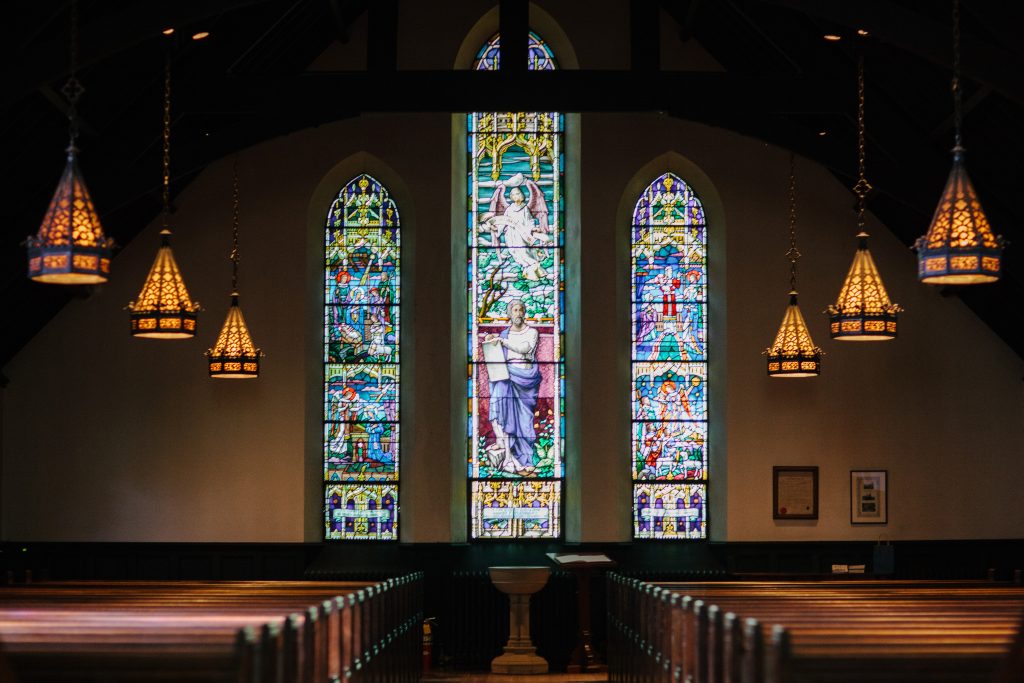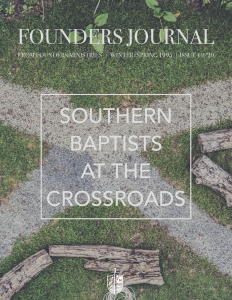Introduction
There is no doubt that denominations can be pernicious creatures. Enshrining error and immortalizing institutions, they can too easily be living shrines to doctrinal distinctives, while obscuring the essentials of the great Christian gospel which alone is our salvation. Examples of this sad truth abound at every hand. There is no human institution which is not touched by the fallenness of the humans involved with it.
And yet, while eschewing a shallow triumphalism, we can still thank God for His mercies to us as individuals, as churches, and in the organizations which are the result of God-inspired leadership. Just such an institution is the Southern Baptist Convention. Born out of a combination of motives which could only come from creatures fallen, but made in the image of God, the Southern Baptist Convention was designed to spread the good news of Christ, and to ensure that slave-holders would not be excluded from this great task.
The denomination which grew in the tumultuous middle decades of the nineteenth century, though itself new, was composed of men and women from churches with traditions of ministry and service which long predated 1845. Though the denomination might be described as being in its infancy, the tradition of Baptist Christians was a comparatively long-established part of American religious life.
Part of the established tradition of these Baptists was a comparatively articulate, robustly reformed theology, shared in large part with Presbyterian, Congregational, and many Episcopalian pastors around them. For all of the disagreements and even tribulations which established denominations had inflicted on those unestablished churches (particularly Baptist churches), the understanding of the Christian gospel, indeed of most of Christian theology, was not a contentious issue.
John Dagg and His Theology
John Leadley Dagg (1794-1884) was one who inherited and disseminated this body of shared protestant theology, albeit with baptistic distinctives in matters of baptism and church government. His particular distinction comes in being the first Baptist theologian in the south to publish a systematic theology after 1845. In 1857, the Charleston-based Southern Baptist Publication Society (predecessor to the Sunday School Board) published his 379-page Manual of Theology. This was followed the next year by the Society’s publication of his 312-page companion volume Treatise of Church Order, and the next by the publication of his Elements of Moral Science. The first two of these, used as theological textbooks throughout the second half of the nineteenth century, were later republished together as the Manual of Theology and Church Order (Gano Books, 1982).1 As a tribute to the labors of this influential Southern Baptist theologian, this brief article offers a description of Dagg’s theology and a defense of its lasting value.
As has already been intimated, Dagg’s theology was reformed, or Calvinistic. His theology was not Calvinistic in the sense of being a full reproduction of the teachings of John Calvin (1509-1564). Calvin’s teachings are too far-reaching and complex to be accurately summarized by a single word. On the other hand, Dagg’s understanding of Christian theology was Calvinistic not merely in the sense of affirming the sovereignty of God, but in the sense of holding to what are often termed the “five points.” First formulated in the Remonstrant controversy in seventeenth-century Holland, the “five points” of the Synod of Dort (1619) were popularized in England and America in the seventeenth and eighteenth centuries by religious controversy over Arminianism.2 For two hundred years these doctrines were the dominant orthodoxy of many American Protestants, including the Baptists.
Dagg’s Manual teaches that our most reliable and most important knowledge of God comes through His perfect Word written, the Bible. This is the book which teaches us of God and His ways with us, and of the response which we are to make to Him. With traditional arguments and texts, but with striking concision and moving devotion, Dagg presents the student with the infinitely attractive God of the Bible–one, spiritual, omnipresent, eternal, immutable, omniscient, omnipotent, infinitely good, always truthful, perfectly just, holy and wise. This is the God who has created us, and revealed Himself to us, teaching us how to live while sovereignly ruling over his creation.
Doctrine of Man
Dagg neither defends or attacks the freedom of the will, but rather defines it quite carefully, so as to exclude a reduction of humans to automatons on the one hand, or irrational, motive-less actors on the other. (Dagg had evidently read Jonathan Edwards’ On the Freedom of the Will, though he doesn’t cite it.)
“The first man, having been placed under a covenant of works, violated it, and brought its penalty on himself and his descendants.”3 So, Dagg taught, in Adam we all fell. Today, all people sin, thus displaying their fallen natures. Born under God’s judgment, we are unable to help ourselves out of our mortal trouble. This help we require comes to us only by God’s grace through Jesus Christ. Jesus Christ, Dagg taught, was fully human and fully divine. The Son of God, “assumed human nature, and in that nature lived a life of toil and sorrow, and died an ignominious and painful death…was raised from the dead, ascended to heaven, and was invested with supreme dominion over all creatures.”4 As prophet, priest and king, the mediator Jesus Christ reveals, offered himself as sacrifice, intercedes and rules. He briefly treats God the Holy Spirit as the Divine sanctifier and comforter of His people.
Doctrine of Salvation
Dagg presents the plan of God’s salvation of sinners as a covenant made within the Godhead before creation, whereby God would graciously save all who repent of sin and believe in Christ. This comes about by the gracious work of the Holy Spirit changing us, sanctifying us, and preserving us to the end. As does Calvin in his Institutes, so it is at this point in his theology that Dagg expounds the biblical doctrines of election, particular redemption and effectual calling, as he meditates on the saving work of God the Father, God the Son and God the Holy Spirit. Who can deny that the Bible clearly teaches that God’s work of salvation is a work of wonderful unity? God the Father graciously elects, God the Son gives Himself as a substitute for, and God the Holy Spirit gives the new birth to the same group of people. Finally, Dagg teaches the immortality of the soul, the resurrection of the body, and the final judgment which results in the righteous being taken to Heaven, and the wicked cast eternally into Hell.
Doctrines of Baptism and the Church
As might be expected in a Baptist Treatise on Church Order, Dagg gives the largest single amount of space to a consideration of baptism. He explores the command to be baptized, the etymology of the relevant words, the theological significance of it, the proper subjects of it, its relation to church membership, and its administration. He has a special section where he considers the traditional reformed arguments for infant baptism, concluding that they are far from compelling.
Many other matters are also addressed in his Treatise on Church Order. He defends the nature of the church as being most certainly local, but, as over against the Landmarkist tradition which would soon arise, Dagg held to a traditional understanding of the universal church as “the whole company of those who are saved by Christ.”5 Nevertheless, he maintains that, unlike the unity of the local church, the unity of this church is to be displayed spiritually, and not organizationally. Dagg defends “strict communion” in which only those who have been baptized as believers are to be admitted to the table, and public worship and the ministry of the Word as divinely ordained duties of the church.
Dagg’s Ministry
While many today might wonder if such a thoroughly Calvinistic preacher could ever find useful service with evangelistically-minded Baptists, Dagg’s years of productive ministry ought to remove all doubt. Indeed, the long list of his services to churches and denominations alone should put to rest any idea of Calvinism leading to lazy inactivity.
Converted in 1809, at the age of fifteen, Dagg knew half a century of fruitful ministry from the time of his ordination in November, 1817, until his infirmities forced him into virtual immobility. In Virginia, from 1817 until 1825, he pastored several small churches, and helped to begin his local association, and the Baptist Convention of Virginia. In 1825 he moved to Pennsylvania, where he took up the pastorate of the prominent Fifth Baptist Church of Philadelphia, which, at the time, was one of the largest congregations in the city. Dagg was an officer in the Philadelphia Baptist Missionary Society (1825-1827) and one of the founders of the Pennsylvania Baptist Missionary Society (forerunner of the Pennsylvania Baptist Convention): He was also the host pastor for the 1829 Triennial Convention (mother of the SBC, ABC and other Baptist denominations in America).
Dagg served on the Board of Managers of the Triennial Convention (1826-1836), as a Vice-President of the Triennial Convention (1838-1845), on the Board of Directors of the American Baptist Home Missionary Society (1832-1836), as Vice-President of the American and Foreign Bible Society (1837-1843), and as President, Vice-President and other positions of the Baptist General Tract Society (1824-1843). He was particularly concerned for mission work in western Pennsylvania and in the evangelization of the Cherokee nation in Georgia.
In the providence of God, this article about Dagg may be written because of a failure in his ministry. In 1834 Dagg’s otherwise successful pastorate in Philadelphia ended due to the loss of his voice. Apart from this failure, would he ever have turned his efforts from the pulpit to the pen? Wanting to retain his services in the area, the Baptists of the Philadelphia Association approached him about serving as President and Professor of Theology at a new school (the Haddington Institute) they desired to open. Dagg accepted the position and served there until 1836, at which time the school was dissolved.
From 1836 to 1844, Dagg served as President of the Alabama Female Athenaeum in Tuscaloosa, Alabama. During this time Dagg was active in the Alabama Baptist convention, serving on committees, and as an officer, also helping form the Alabama Baptist Bible Society and serving as its President for two years.
The great distance of Alabama from the eastern seaboard made Dagg’s continued participation in national Baptist meetings difficult. Expressing regret to Dagg about his absence from the troubled 1841 Triennial Convention in Baltimore, Spencer H. Cone (1785-1855), prominent Baptist minister in New York City and longtime friend, wrote, “I was much disappointed in not seeing you in Baltimore,…that you lacked `influence’ either with the South or North, I cannot, for a moment, admit, for I know no one whose voice would have commanded more respect in our anxious and important session….”6
Dagg served at Mercer University, in Georgia, as President (1844-1854), and as professor of theology (1844-1855). There he labored to build the theological department until, in the early 1850’s, it was perhaps the most celebrated theological school in the south. During his successful tenure at Mercer, Dagg was still called upon for larger denominational service. Upon moving to Georgia, Dagg became active in the Georgia Baptist Convention, where he served on the Executive Committee (1844-1855). Dagg was one of ten people appointed to meet on April 28, 1845 in Providence, Rhode Island to arrange for the dissolution of the American Baptist Home Missions Society. One month later, while attending the organizational meeting for the Southern Baptist Convention, he was appointed as one of the Vice-Presidents of the new Domestic Missions Board of the Southern Convention. He also was appointed to the committee to draw up the constitution for the new convention. Dagg again attended the Southern Baptist Convention in 1849. His activities there included chairing a committee on the China mission, and delivering its report to the convention, and addressing the Convention as a corresponding messenger from the American Sunday School Union. In 1856, Dagg retired from teaching theology at Mercer. His remaining years were spent in publishing material, much of which was, no doubt, constructed from his classroom lectures at Mercer.
Dagg’s Legacy
Throughout his long life of service, Dagg had developed many close relationships with the religious leaders of the day, and was highly regarded. J. R. Jeter considered him an outstanding preacher. Dagg counted among his closest and oldest friends some of the most influential Baptist leaders in the nation–William Fristoe, Spencer H. Cone, Noah Davis, Joseph Kennard, David Jones, Basil Manly, Sr., and P. H. Mell. His service at Mercer was well-known and greatly appreciated. His writings also served to keep his thoughts often before the minds of thousands of his fellow ministers. In 1879 during the meeting of the Southern Baptist Convention in Atlanta, W. H. Whitsitt moved that “a catechism…containing the substance of the Christian religion” be drawn up by the venerable J. L. Dagg. The resolution passed unanimously. Such was the respect and influence of John Leadley Dagg. His Manual of Theology saw widespread use throughout the rest of the nineteenth century, extending his influence far beyond his many students, listeners, friends and family.
Evidence of enduring appreciation for Dagg’s work can be seen by the fact that almost forty years after his retirement, when a new theology professor was to be appointed at Mercer in 1893, he was recommended by the simple statement that if this person “needed any endorsement, it would be sufficient to say that he was a student under that incomparable theological teacher, Rev. J. L. Dagg, D. D., and that he uses his Systematic Theology, as a text book.”7
Another aspect of Dagg’s life which is often overlooked is the influence that he exerted beyond his own person, not merely through his preaching, teaching, writing, and denominational service, but through his family. His son, John F. Dagg served as pastor of the Baptist church at Milledgeville, Ga. (1847-1851), editor of the Georgia Baptist paper, The Christian Index (1851-1857), clerk of the Georgia Baptist Convention (1855), pastor of the Cuthbert Baptist Church (1857-1866), professor (1857-1866) and President (1861-1866) of Cuthbert Female College in Cuthbert, Georgia, and President of Bethel Female College, Hopkinsville, Kentucky (1866-1872).
Dagg’s stepson by his second wife’s first marriage was Noah K. Davis. Since his father died when he was only a few months old, Dagg was the only father that Davis ever knew. Davis graduated from Mercer in 1849. He served as President of Bethel College in Russellville, KY and later became widely celebrated as Professor of Moral Philosophy at the University of Virginia. (In this capacity, Davis delivered one of the first series of Gay Lectures at the Southern Baptist Theological Seminary in 1901.)
Dagg’s daughter Elizabeth married S. G. Hillyer, a prominent Baptist minister in Georgia who served successively as Professor of Belles Lettres and Theology and President of Mercer University. Their son, J. L. Dagg Hillyer had a daughter, Georgia Hillyer, who married John Roach Stratton, the famous fundamentalist Baptist pastor of Calvary Baptist Church, New York City. In 1926 their son Hillyer Hawthorne Stratton wrote the first thesis on Dagg. Another daughter of Dagg’s, Mary Jane, married Rollin D. Mallary, son of the well-known Georgia Baptist, C. D. Mallary. R. D. Mallary graduated from Mercer in 1851, served as President of Southwestern Baptist College in Cuthbert, Ga., Shorter College in Rome, Ga., and Shelby Female College in Shelby, N. C.
Dagg’s reputation faded with the ending of the nineteenth century, as his systematic theology was replaced first by that of James P. Boyce, then by Boyce as revised by F. H. Kerfoot, and finally by E. Y. Mullins and W. T. Connor. Yet with the republication of Dagg’s theology in 1982, a new generation of ministers and church members have come to appreciate this man’s gift for writing a theology which is faithful to the Bible, clear to the mind, and warming to the heart. If no other writer has been able to convince readers of this article that true knowledge of God involves both head and heart in knowing the searching love of our gracious God, then let John L. Dagg have that privilege. He has been a trusted guide for many before; he can be trusted still. As the present author has written elsewhere of Dagg, it must be stated that if Dagg is not a particularly notable doctor in the content of theology–finding no new truths or novel expressions–he is almost unsurpassed among Baptists as a doctor in the purpose of theology. Dagg would teach that if the pursuit of theology is to be legitimate, its purpose must be clear. To pursue knowledge of the Biblical God, can only properly be done by seeking to know the Biblical God. To be captivated by the knowledge of God is idolatrous, unless one is captivated by God Himself. That Dagg was so captivated himself is clear; that he may so teach us is his enduring contribution.
1 These two volumes have since been reprinted separately and are available from Cumberland Valley Bible Book Service at P.O. Box 613, 133 North Hanover Street, Carlisle, PA 17013.
2 The five points of the Canons of Dort (1619) are, summarily, 1) Unconditional Election, 2) Radical or Total Depravity, 3) Definite or Particular Atonement, 4) Effectual Calling, 5) Preservation of the Saints. In this article words “Reformed” and Calvinistic” are used interchangeably.
3 Dagg, Manual of Theology, p. 144.
4 Dagg, Manual of Theology, pp. 205-206.
5 Dagg, Treatise on Church Order, p. 100.
6 Letter of Cone to Dagg, in Life of Spencer Cone, p. 255.
7 The Christian Index, March 2, 1893, p. 3.























